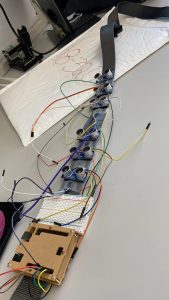This week, I have mostly been doing some preparation work for finalizing our project in the final week. I have ordered some new parts to help rebuild the belt. Currently I am still waiting on the parts to arrive before I reroute the circuit. But I have tested out the individual parts and ruled out components that are broken (since vibration motor disks and sensors are quite cheap, they can be quite unrealiable). I have done some basic testing to make sure that the ultrasonic and vibration sensors work as expected, and only need to wait on a few components to finish up assembling the final form of the belt next week.
Apart from the belt, I am also looking into developing a visualization system for the belt’s functionality. The basic idea is to feed the processed information from the raspberry pi to another PC through USB. I would hope to include both the video feed from the depth camera, as well as the information from the sensors. The visuals would indicate how the belt is producing effective warnings and how it is recognizing risks, so that observers can understand the belt without having to put it on. This would help us demonstrate the belt much better.
Next week, I will look to finish up on the two points above, and transition to testing before the weekend.


